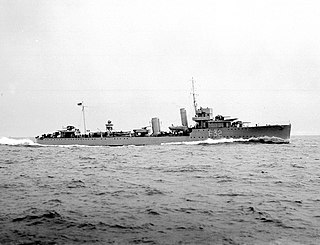
The Royal Navy (RN) is the naval warfare force of the United Kingdom, British Overseas Territories and Crown Dependencies, and a component of His Majesty's Naval Service. Although warships were used by English and Scottish kings from the early medieval period, the first major maritime engagements were fought in the Hundred Years' War against France. The modern Royal Navy traces its origins to the early 16th century; the oldest of the UK's armed services, it is consequently known as the Senior Service.

The Royal Naval Reserve (RNR) is one of the two volunteer reserve forces of the Royal Navy in the United Kingdom. Together with the Royal Marines Reserve, they form the Maritime Reserve. The present RNR was formed by merging the original Royal Naval Reserve, created in 1859, and the Royal Naval Volunteer Reserve (RNVR), created in 1903. The Royal Naval Reserve has seen action in World War I, World War II, the Iraq War, and War in Afghanistan.

HMS Bristol (D23) was a Type 82 destroyer, the only vessel of her class to be built for the Royal Navy. Bristol was intended to be the first of a class of large destroyers to escort the CVA-01 aircraft carriers projected to come into service in the early 1970s but the rest of the class and the CVA-01 carriers were cancelled as a result of the 1966 Defence White Paper which cut defence spending.

The Commander-in-Chief Fleet (CINCFLEET) was the admiral responsible for the operations of the ships, submarines and aircraft of the British Royal Navy from 1971 until April 2012. The post was subordinate to the First Sea Lord, the professional head of the Naval Service. In its last years, as the Navy shrank, more administrative responsibilities were added.

The University Royal Naval Units (URNU) are Royal Navy training establishments who recruit Officer Cadets from a university or a number of universities, usually concentrated in one geographical area. There are 17 URNUs in the UK, with each URNU having land-based facilities near the universities they recruit from, with the exception of URNU Virtual, whose drill nights are conducted virtually.

HMS Sultan is a shore base of the Royal Navy in Gosport, Hampshire, England. It is the primary engineering training establishment for the Royal Navy and home to the Network Rail Advanced Apprenticeship Scheme and the EDF Energy engineering maintenance apprenticeship.

The Bermuda Sea Cadet Corps was created in 1966 and registered as a charity under the Bermuda Sea Cadet Association Act, 1968. The first unit had actually been created two years earlier.

848 Naval Air Squadron was a squadron of the Royal Navy Fleet Air Arm. It operated the Westland Sea King HC.4 helicopter and previously provided advanced flying training to pilots for the other squadrons in the Commando Helicopter Force. The squadron was based at RNAS Yeovilton in Somerset and was decommissioned on 24 March 2016.

HMS Eaglet is a Royal Navy Reserve unit based in Liverpool. She is the main occupant of the Royal Navy Regional Headquarters in Liverpool, Merseyside. The base is also the home to a number of units, including:Royal Marines Reserve Merseyside, Naval Regional Command Northern England, Liverpool URNU, HMS Biter, HMS Charger, Sea Cadet Corps, and the Liverpool Royal Navy and Royal Marines Careers Office.

HMS President is a "stone frigate", or shore establishment of the Royal Naval Reserve, based on the northern bank of the River Thames near Tower Bridge in Wapping and is in the London Borough of Tower Hamlets.
HMS Hodgeston was a Ton-class minesweeper which saw service with the Royal Navy during the Cold War. Built by Fleetlands Shipyard, she was launched on 6 April 1954 and broken up in 1988.
A ship and a shore establishment of the Royal Navy have borne the name HMS Flying Fox, after the racehorse Flying Fox.

The first HMS Wessex (D43) was a W-class destroyer of the British Royal Navy that saw service in the final months of World War I and the early months of World War II.
HMS Dalriada is Glasgow's Royal Naval Reserve unit. It is based in Govan, one of the city's south-western suburbs.

The Nautical Training Corps (NTC) is a National Maritime Training and Uniformed Youth Organisation based in the south of England. Registered Charity Number: 306084, Cadets follow similar rates and ranks, traditions, values and ethos as the British Royal Fleet Auxiliary (RFA) and the Merchant Navy.
In 1989 the Royal Navy was under the direction of the Navy Department in the UK Ministry of Defence. It had two main commands, CINCFLEET and Naval Home Command.

HMS Sherwood is a Royal Naval Reserve shore establishment in Nottinghamshire, England. The first naval reserve unit was established in Nottingham in 1949. It was commissioned as Sherwood in 1984, at which time the unit was based at Chalfont Drive, Beechdale. A Royal Marines Reserve detachment was added to the unit in 2007. In 2014 HMS Sherwood moved to Chetwynd Barracks, Chilwell, where it was co-located with an Army Reserve unit. Sherwood was honoured by receiving the freedom of the city of Nottingham in 2018.

The University Royal Naval Unit East Scotland is one of 17 University Royal Naval Units and a Royal Navy training establishment based in Scotland, accepting roughly 65 Officer Cadets from universities in Edinburgh, Fife and the Tayside region. It is one of the University Service Units and is under the command of Britannia Royal Naval College, Dartmouth. The unit's affiliated P2000 ship is HMS Archer, which is predominantly used for training Officer Cadets.














